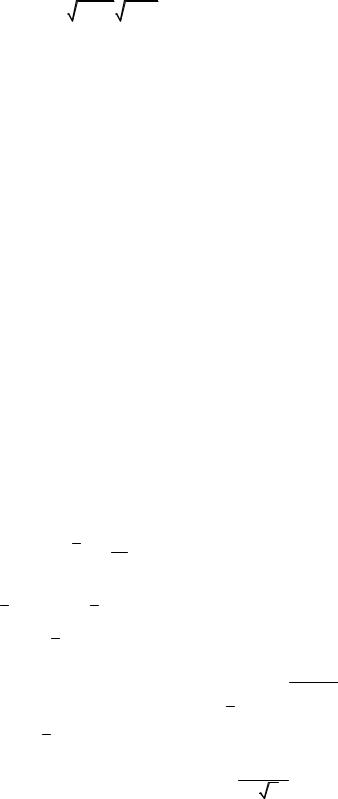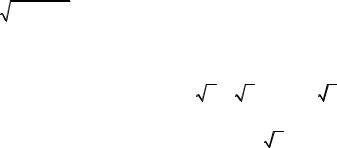
Lektsii (1) / Lecture 13
.pdf
|
ICEF, 2012/2013 |
|
STATISTICS |
|
1 year |
|
LECTURES |
Lecture 13 |
04.12.12 |
COVARIANCE AND CORRELATION
Let X and Y be two random variables with some joint distribution.
Definition. The number Cov(X ,Y ) = E ((X −µX )(Y −µY )) is called the covariance of the random variables X and Y where µX = E(X ), µY = E(Y ) .
We will also use the notation Cov(X ,Y ) =σXY /.
Proposition 1. Cov(X ,Y ) = E(X Y ) −µX µY .
Proof. Cov(X ,Y ) = E ((X −µX )(Y −µY ))= E(XY −µX Y −µY X + µX µY ) =
= E(XY ) −µX E(Y ) −µY E(X ) +µX µY = E(XY ) −µX µY , |
QED |
It follows from the definition that Cov(X , X ) =V (X ) . |
|
By direct calculation we get the following property of the covariance.
Proposition 2. Let X and Y be two random variables and a, b, c, d be some constants. Then
Cov(aX +b,cY +d ) = acCov(X ,Y ) .
Proposition 3. Let X and Y be two random variables. Then
V (X +Y ) =V (X ) +V (Y ) +2Cov(X ,Y ) .
Proof. We have
V (X +Y ) = E ((X −µX ) +(Y −µY ))2 = E ((X −µX )2 )+ E ((Y −µY )2 )+
+2E ((X −µX )(Y −µY ))=V (X ) +V (Y ) +2Cov(X ,Y ) , QED
Proposition 4. Let X and Y be two independent random variables. Then
E(X Y ) = E(X ) E(Y ) = µX µY .
Proof. We have (we use the standard notations from the previous lectures)
m n |
m n |
m |
|
n |
|
|
E(X Y ) = ∑∑xi y j pij = ∑∑xi y j pii |
pi j = ∑xi pii |
∑ y j pi j |
= |
|||
i=1 j=1 |
i=1 j=1 |
i=1 |
|
j=1 |
|
|
m |
m |
|
= ∑xi pii µY |
= µY ∑xi pii = µY µX , |
QED |
i=1 |
i=1 |
|
Using Propositions 1, 4 we get
Proposition 5. If random variables X and Y are independent then Cov(X ,Y ) = 0 .
The inverse statement is not true, i.e. Cov(X ,Y ) = 0 does not imply independence of X and Y.
Proposition 6. If random variables X and Y are independent then V (X +Y ) =V (X ) +V (Y ) .

Since Cov(X ,Y ) has the dimension that is equal to the production of dimensions X and Y it
could not be used as a measure of “dependency” of X and Y. The modification of the covariance is the coefficient of correlation or simply correlation:
Definition. The number
Corr(X ,Y ) = |
Cov(X ,Y ) |
= |
|
σXY |
|
V (X ) V (Y ) |
σX σY |
||||
|
|
||||
is called the coefficient of correlation or simply correlation.
We will also use the notations Corr(X ,Y ) = ρXY = ρ(X ,Y ) .
Obviously correlation has no any dimension.
PROPERTIES OF CORRELATION
1.−1 ≤ ρ(X ,Y ) ≤1 for any random variables X and Y.
2.If random variables X and Y are independent then ρ(X ,Y ) = 0 .
3. If ρ(X ,Y ) =1 then there are constants a > 0 and b such that Y = aX +b ; if ρ(X ,Y ) = −1 then there are constants a < 0 and b such that Y = aX +b .
Random variables X and Y for which ρ(X ,Y ) = 0 are called uncorrelated. So, independent
random variables are independent but not vise versa.
The correlation is considered as a measure of linear relationships between X and Y.
LAW OF LARGE NUMBERS (LLN)
CENTRAL LIMIT THEOREM (CLT)
Let X1, X 2 ,... be an infinite sequence of independent and identically distributed random variables, E(Xi ) = µ, V (Xi ) =σ2 . Note that expectations and variances are the same for all random variables (why?). Let’s denote
Sn = ∑n Xi = X1 + X 2 +...+ X n − the sum of the first n terms of the sequence.
i=1
Obviously, E(Sn ) = n µ , and from Proposition 6 it follows that V (Sn ) = n σ2 . Finally, consider the random variables X(n) = Snn , n =1,2,... − the sequence of sample means of the first n terms of
the sequence. From the basic properties of expectation and variance it follows that
E (X(n) )= µ, V (X(n) )= σn2 .
Theorem (LLN). X(n) → µ as n →∞.
This statement is equivalent to the following statement: Sn −nnµ →0 as n →∞.
Informally this means that the randomness in X(n) disappears as n →∞. Intuitively it is quite clear because V (X(n) )→0 as n →∞.
Now consider the random variables Tn = Sσn −nnµ , n =1,2,... . It can be easily checked that
E(Tn ) = 0, V (Tn ) =1 .

Theorem (CLT). The distributions of random variables Tn tend to the distribution of the standard normal random variable Z as n →∞, i.e. Pr(a <Tn <b) → Pr(a < Z <b) for any a < b.
Particularly, the normal approximation can be applied to the binomial random variables. In fact, let Bn Bi(n,π) , then Bn is the total number of successes in n trials. Let’s introduce the random
|
|
0, if in i |
th |
trial false, |
|
i =1,…, n. |
|
|
|
|
|
|
|
|
|
||||||||||
variables εi = |
|
|
|
|
|
|
|
|
|
|
|
||||||||||||||
|
1, if in ith trial success. |
|
|
|
|
|
|
|
|
|
|
|
|
|
|
|
|||||||||
|
|
|
|
|
|
|
|
|
|
|
|
|
|
|
|
|
|
|
|
|
|
|
|
|
|
Then ε1,...,εn are independent and identically distributed random variables, |
|
|
|
||||||||||||||||||||||
E(εi ) =π, V (εi ) =π(1−π) . Finally, Bn |
= ∑n |
εi , so we can use CLT for Bn : |
|
|
|
||||||||||||||||||||
|
|
|
|
|
|
|
|
|
|
|
|
i=1 |
|
|
|
|
|
|
|
|
|
|
|
|
|
|
The distribution of |
|
Bn −nπ |
|
|
tends to the distribution of a standard normal random |
|
||||||||||||||||||
|
|
nπ(1−π) |
|
|
|||||||||||||||||||||
|
variable Z. |
|
|
|
|
|
|
|
|
|
|
|
|
|
|
|
|
|
|
|
|
|
|
||
|
Back to sample means. Since |
|
|
(n) = |
Sn |
= µ + |
Sn −nµ |
|
σ |
≈ µ +Z |
σ |
then for large n |
|||||||||||||
|
X |
||||||||||||||||||||||||
|
|
|
n |
n |
|||||||||||||||||||||
|
|
|
|
|
|
|
|
|
|
|
|
|
|
n |
σ n |
|
|
|
|
|
|||||
|
|
(n) has approximately normal distribution N µ, |
σ |
whatever is the |
|||||||||||||||||||||
the sample mean X |
|||||||||||||||||||||||||
|
|||||||||||||||||||||||||
|
|
|
|
|
|
|
|
|
|
|
|
|
|
|
|
|
|
|
|
n |
|
|
|
||
distribution of |
X1, X 2 ,... . |
|
|
|
|
|
|
|
|
|
|
|
|
|
|
|
|
|
|
||||||
